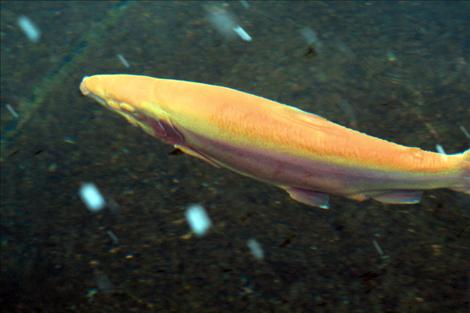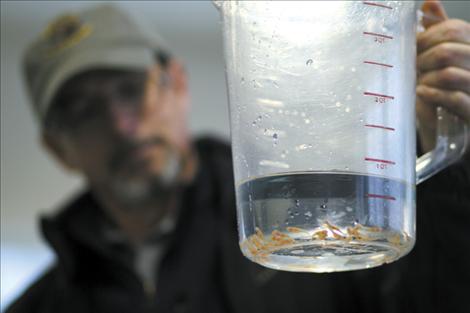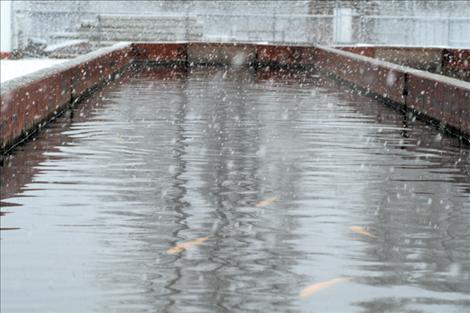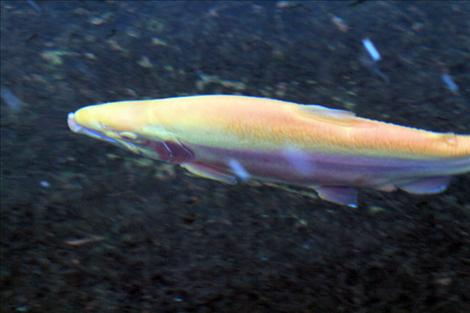Jocko River Trout Hatchery spawns 2,000 albino trout
Hey savvy news reader! Thanks for choosing local.
You are now reading
3 of 3 free articles.
ARLEE — The Jocko River Trout Hatchery in Arlee got a colorful surprise in the spring of 2009 when it spawned roughly 250 albino trout — an interesting and rare occurrence.
According to hatchery employee Ron Snyder, the Arlee strain of rainbow trout genetics was created in the 1950s. Since the hatchery’s beginnings, no new trout genetics have been added. This means the albino gene has been passed down from fish to fish over the past 50 years until, by chance, the hatchery spawned about 250 albino trout in 2009. The last time the hatchery saw an influx of albino trout was 1992.
Once big enough to fend for themselves, Snyder released the remaining 75 albino trout into one of the hatchery’s show tanks. The tanks are concrete runways about 3 feet deep with a dark bottom.
Albino rainbow trout are neon orange with a bright red stripe running down the length of their sides and pink eyes.
As the bottom of the tank provides such a stark contrast against the fish, the 75 albino trout quickly dwindled down to the 20 still present at the hatchery.
“The ospreys, great blue herons, king fisher and bald eagles just zero in on them. “(The albinos are) like swimming lightbulbs, and there’s no cover for them against the bottom of the tank,” Snyder said.
The 20 fish that survived to adulthood did so by ducking out to the corners of the raceway and hiding under turbulent water created by the tank’s circulation system when predators were nearby.
Seeking to learn more about the albino gene, Snyder took the eggs from one albino female and fertilized half of them with sperm from an albino male. The other half was fertilized with sperm from a normal male phenotype.
The offspring hatched three weeks ago with surprising results.
The offspring hailing from both a male and female albino rainbow trout hatched with 100 percent albinism — roughly 2,000 orange and red albino fry.
However, the offspring resulting from a normal phenotype male combined with an albino female resulted in no albino offspring. This means the albino gene in this particular strain of rainbow trout is homozygous recessive.
“(The albino trout) are not part of any program we have as far as stocking; it was just kind of a site-interest thing to see what would happen if the fish actually produced viable eggs,” Snyder said.
Snyder estimates that around 95 percent of these albino fish will survive to adulthood, “Unless they get picked off. Poor little buggers, I should give them camouflage jackets.”
In addition to their neon orange and red color, these trout are less aggressive and much smaller than the normal phenotype of fish in the same age group. Snyder is uncertain if this change in behavior and size is directly linked to albinism, as it could also be caused by larger, older and more aggressive fish sharing the same tank.
However, should the fish survive the hungry eyes of skyward predators, the albino trout might have a much longer life.
Rainbow trout in the wild generally live between three and four years. In a hatchery setting with a degree of protection from predators and stable food intake, they can live up to eight years.
Several albino trout from the 1992 strain lived more than 10 years.
“Pretty amazing.
“It doesn’t occur a lot here, and that’s a good thing,” Snyder said. “It is not expressed often enough that we would be concerned that we’re losing the variability of the gene pool, especially when you consider that they’ve been captively held for more than 50 years.”
The Jocko River Trout Hatchery has no plans to introduce the albino rainbow trout into the wild.
“You don’t want that gene floating around out there, because it’s just not something you see in the wild. You don’t generally catch these things; I don’t, and I don’t know of anyone else who does,” Snyder said.
The hatchery does not plant trout where they might be able to reproduce in the first place, making the debate on stocking these fish a moot point, but Snyder said it’s not a risk worth taking.
“All the reproduction programs are trying to not influence wild trout genetics and keep the reservoirs, lakes and streams as wild as possible,” he said. “Especially when it comes to native species management and areas of cutthroat trout management, we are very conscious of trying to keep it the way it is.”
Snyder said there is a possibility that the trout will be sent to an educational center near Helena and to other hatcheries around the state for their public display tanks.
The Jocko River Trout Hatchery produced 5.5 million eggs last year with an average survival rate of 95 percent. These soon-to-be fish were sent to hatcheries around the state, raised, and released into ponds, reservoirs and lakes for the benefit of fishermen, bear and eagle alike.



















